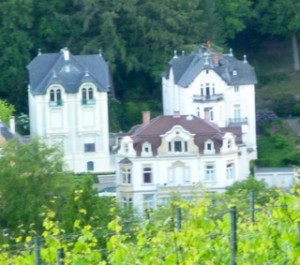After an uneventful three week stay in New Jersey (except for the ambulance trip for my spouse and a number of mostly annoying family dramas, along with happy get togethers with friends) we headed for Germany in late May. There we spent a few very fine days with an ex-pat Aussie friend. Her lifestyle can’t be typical there, as her family is all professionals with equally successful and multi-lingual children, but they aren’t that unusual either.
At the brink of retirement they kitted out their house with all the extras to keep them cosy. In that climate, it means triple glazed windows. The walls are about 60 cm thick, and have been layered on the outside with an additional blanket of insulation, and then rendered over so you can’t tell. Most interestingly, they have taken advantage of the generous German feed-in tarriff for renewable energy, and placed 12 Kws of panels on their conveniently south-facing roof:

This means they make about 4000 euros a year off their roof, with a payback time of 7 years and a lifespan of the installation of about 20. Some argue that this feed-in tarriff is not a good investment, but from the trains we could see that a substantial number of homes and businesses now have solar panels, far more than anywhere else I’ve seen. This has to be a good start, and gets people used to thinking about energy in new ways.
Far from being old and rusted-on, the Europeans strike me as being more willing to consider experiments. For example, this apartment block in Darmstadt was designed some decades ago by the artist Hundertwasser. It includes elements of social and environmental sustainability that have made it an icon in some circles. It is surrounded by gardens and apparently is much sought after to live in, although the Gaudiesque features may not be everyone’s cup of tea:

Germany has got almost everything right. No wonder they chaff at bailing out the rest of the Eurozone. Seeing how Europe provides public transport is an eye-opener for a parochial Aussie like myself, whose main comparison has been the even less sensible United States. In New Jersey, for example, if my mother’s the small town didn’t provide the town mini bus to take oldies shopping (four times per week, twice for supermarkets and twice to big malls) getting groceries would be a serious problem for some of them, since public transport is so sparse. However, this also highlights the importance of maintaining mobility, as we were able to keep the groceries flowing by walking the ten minutes to a supermarket or pharmacy with backpacks. This might not work so well in winter.
It seems that in that part of New Jersey at least, public transport was actually better in the 1950s, before everyone got cars. My mother recalls that she used to travel home by bus at lunchtimes and back in an hour from the next town, an impossible trip now.
In Germany, by contrast, we were able to walk to the closest train station (less than 200 metres away in a small village) and then get to a bigger town and jump onto a train to get almost anywhere in Europe. Even with the much higher population density, it is hard to see why at least the largest 25 cities in Australia couldn’t have similar access. The largest 25 cities were the focus of our government’s urban planning strategy document, which, if I recall, omitted serious discussion of public transport.
Our impressions of German pleasantness and efficiency were tempered by the charm of the Rhineland landscape, and the pretty scenes from hills. What awaited us in Munich was even more eye-opening.
